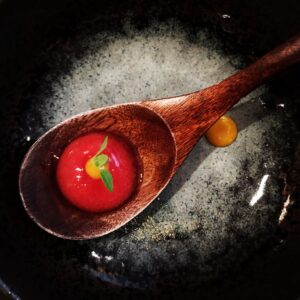My previous life as a winemaker found me living amidst the rolling hills of southeastern Washington’s Palouse. Carved out by the Missoula floods and crowned in layers of wind-blown loess, it’s a breathtaking landscape that attracts photographers from all over the world. Following harvest, the region changes her gown from green to gold. In the late afternoon sunlight, the halcyon stubble left behind pops against a backdrop of dark storm clouds.
That rare, luminous quality of light is hard to find. I caught a glimpse of it on the TGV train that connects Paris to Reims as it skirted around the eastern edge of France’s breadbasket, the Paris Basin, swiftly darting through an endless patchwork of cereal crops and soft winter wheat, before pulling into the railway station in Reims. The city, too, is bathed in a warm cream-grey limestone palette, it’s buildings a stately mix of medieval and art deco architecture.
Champagne itself is a place of contrasts and is parsed into three major districts, the Montagne de Reims, the Vallee de la Marne, and the Chardonnay-dominant Côte des Blancs to the south. Within each of these sub-regions, one can find a range of different producers to visit, from massive, globally distributed Champagne houses like Veuve Cliquot, Moët & Chandon, and Taittinger to small, family-owned operations that produce agile, terroir-driven grower Champagnes. The wine itself is reason enough to visit—but there is too, an emerging and sophisticated culinary scene that rivals some of the best restaurants in Paris.
Starting in Reims, the crowning jewel in the heart of the Montagne de Reims district, a postcard-worthy city built entirely around its ancient Cathedral. Notre-Dame de Reims is where Champagne’s association with celebration and luxury first took root; dating back to the 13th century, it is has seen countless royal coronations, a ritual that invariably preceded a lavish banquet and toasts with bubbles.
Reims is also home to Racine, a relatively new and stylish Franco-Japanese fusion restaurant owned by chef Kazuyuki Tanaka and his Burgundian wife, Marine. Be sure to make reservations well in advance; this Michelin star restaurant only seats twenty at a time—the space itself is spare and compact, with a dramatic modern spiral staircase that winds it’s way to a small dining area on the second floor. The minimalist atmosphere asks the diner to focus her attention on innovative flavor compositions that pair so magically with bubbles. A meticulously assembled amuse bouche shows a decidedly Japanese pedigree, indeed all of the dishes channel the chef’s lineage. A pop of color here, an unexpected burst of flavor there. The menu is light and lively, and as multifaceted as the wines.

In Montagne de Reims’ sleepy commune of Saint-Imoges, La Table du Bois Joli is a modern, sleek bistro and a worthwhile stop on the Champagne tail. Chef David Mathieu elevates the regions’ traditional dishes with incredible deftness and care. Everything on the menu, from a rich and concentrated slow-roasted veal and cromesquis of Charlotte with fine herbs to their light and charming desserts, each course lends to a deeply satisfying gustatory experience.
Travel yet further south, into the heart of the Côte des Blancs district, and you’ll find an exquisite boutique hotel. Owned by renowned winemaker Anselme Selosse and his wife, Corinne, Hotel Les Avisés is an intimate, ten-bedroom guesthouse and restaurant. Built in the 1960s as a Champagne house, and lovingly restored by the Selosses, it feels very much like a family home. Overstuffed leather couches, cozy throws, and well-placed reading lamps invite guests to pause for a moment of tranquility in an otherwise busy tasting schedule.

In warmer months, guests are encouraged to dine on the patio. The menu, masterfully executed by chef Stéphane Rossillon is one that is decidedly more relaxed than Racine’s, and yet, there is refinement here too. Dishes are inspired by the ever-changing rhythm of locally sourced ingredients, and are transformed into fare that perfectly complements the power and finesse of Selosse’s oxidative wines.
The take away from all of these memorable dining experiences is champagne’s unique versatility. The full-time residents of the region view their wines with a sense of utility—they’re not merely hauled out for special occasions wines, rather they are enjoyed every day. And while that notion is one that is beyond the budget of most Americans (a good champagne is a costly investment), it’s an invitation to try it with a rare dry-aged steak, or a hearty braised dish. A visit to the region will not only enliven the senses and quicken the pulse, but it will also inform the palate. Champagne’s diverse restaurants are the perfect place to learn.
For more on the region and its producers, I recommend the Champagne Bureau’s excellent website: United States Champagne Bureau
